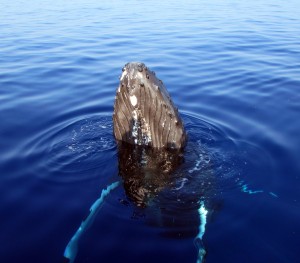Aloha,
On Tuesday’s Wake Up With the Whales Cruise, guests saw 8 different humpbacks. We spent most of our time with a Mom/Baby/Escort pod. Baby was kind of fussy…doing a couple of tail lobs and then rolling on his back and doing a couple of pec slaps every now and then. We saw one breach about 1000 yards from us by a different adult humpback. When we stopped to deploy our hydrophone, not only did we get to listen to some very loud and clear sounds, but while we were sitting there, baby decided to surface – followed by Mom and the escort — and all three of them cruised by us just about 100 feet away. On the Whales and Cocktails Cruise we also saw about 8 different whales — all adults. We saw one breach about a mile away, a peduncle throw and a single tail lob — all from different whales. We also had a close encounter when two big humpbacks surfaced just 50 feet from us.
Mahalo
Claire
Captain Claire’s Humpback Fact of the Day: According the website of the International Whaling Commission (the international agency overseeing whaling) the only countries with people allowed to hunt Humpbacks under the Aboriginal Sustenance Hunting program are a tribe in Greenland (who were allowed 9 West Greenland Humpbacks annually for the years 2010-2012, and 10 Humpbacks annually in 2013 and 2014), and the Bequian people of St. Vincent and the Grenadines, who were allowed a total of 20 Humpbacks between the years 2008 and 2012 and a total of 24 Humpbacks between the years 2013 and 2018. The IWC specifically bans the killing of calves..

